In Hawkesbury Sandstone vegetation a range of parasitic and carnivorous plants can be found. Does it surprise you to know that you could find more than ten different species? Many of these plants can be hard to find: some are ephemeral (short-lived); some very small; a few grow high in the branches of trees; and others are rare.
This document was originally prepared for the Macquarie University Arboretum in 2011 and has been updated and adapted for more general interest. The species list was developed by Alison Downing and the text and photos by Julia Cooke. We thank Denis Wilson, Alan Page and Pam Cooke, for providing some of the photos (as credited).
Parasitic plants
Parasitic plants derive some, or all, of their sustenance, from other plants. There are over 4000 parasitic plant species in the world. They can be either obligate parasites, which means they cannot complete their lifecycles without a host plant, or facultative, where a host is not needed for the completion of the plant’s lifecycle. Wholly parasitic plants, holoparasites, don’t produce chlorophyll and therefore cannot photosynthesise. That is, they can’t convert light energy into organic compounds (sugars) that can be used to fuel their activities. Hemiparasites, partial parasites, produce some chlorophyll and can photosynthesise but pilfer water, nutrients and some organic material from their host or hosts. To do this, parasitic plants have specially modified roots, called haustoria, which invade roots or stems of the host plant and tap into xylem or phloem of the host plant’s vascular system. The plant parasites in the Hawkesbury Sandstones include stem and root parasites, hemiparasites and holoparasites, and may take the form of trees, shrubs, vines or herbs.
1. Exocarpus cupressiformis (Native cherry, SANTALACEAE)
Exocarpus cupressiformis, a small tree, is a root parasite. It is hemiparasitic on nearby Eucalypts. The plant is unusual in that the flower stalks become larger and succulent at fruiting time, forming hard green fruit on tasty stems. These fleshy, tasty flower stalks attract birds that eat the stalks together with the fruit and then spread the seed. The use of fleshy flower stalks to attract seed dispersers is very different from other plants that produce their seeds enclosed in tasty fruits as an attractant.
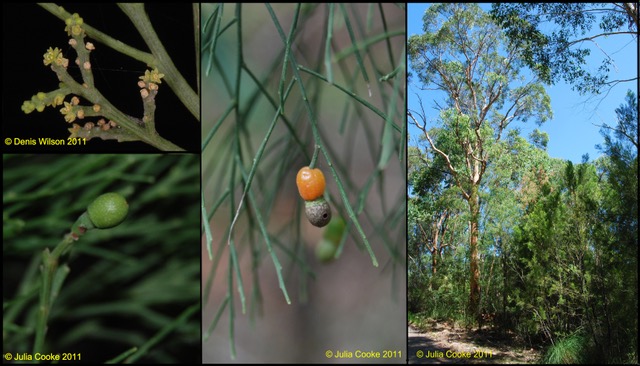
2. Mistletoes (LORANTHACEAE) on Eucalyptus haemastoma
Mistletoes are stem and branch parasites, and you may be able to spot them high in the branches of scribbly gums (Eucalyptus haemastoma) by looking for a cluster of stems and leaves that look slightly different to the other branches and leaves. Three different mistletoe species can grow on this eucalypt including Amyema pendula, Dendrophthoe vitellina and Muellerina eucalyptoides1 . In Australia, many mistletoes resemble the leaves of their hosts. It is not fully understood why, but some theories include convergence in leaf structure and function through adaptation to the same environmental conditions or to avoid detection by herbivores. Despite a similarity in foliage, they produce very different flowers to the host as they seek to attract different pollinators. Australian mistletoes have co-evolved with the mistletoe bird, Dicaeum hirundinaceum, which eats the fruit of mistletoes. The seeds pass quickly through the birds, which digest the sweet fruit, leaving a sticky coat on the seed. When the birds poo, they wipe their bottoms on branches, leaving the mistletoe seed stuck in a perfect spot to grow a new plant, high in the canopy.
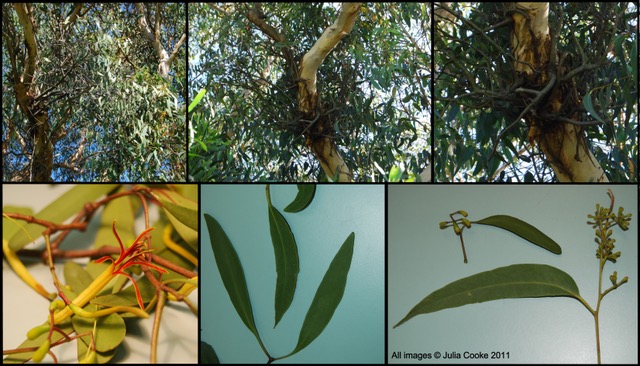
3. Olax stricta (OLACACEAE)
Olax stricta is a root parasite. It is a slender erect shrub that occurs in heath and woodland on sandstone, but it is not abundant and may not be easy to find. Parasitism results in harm to the host and may often limit the density of the host plant. A successful parasite is one that remains in balance with its host, or hosts, to minimise the risk of damaging its access to resources.
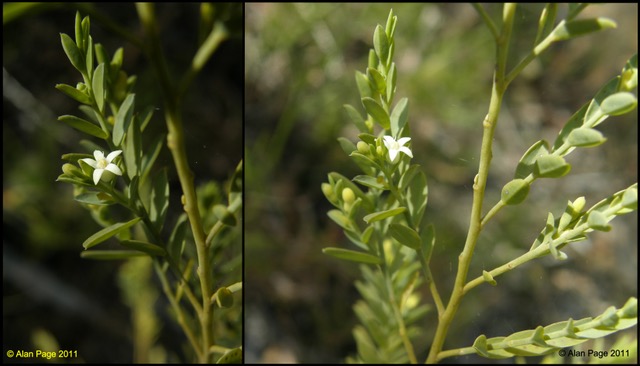
4. Choretrum candollei (Snow Bush, SANTALACEAE)
There are three plants in this vegetation type from the SANTALACEAE family which are all root parasites. Choretrum candollei is rarer than the others but is recognisable by its angular stems and lack of leaves. It is a shrub that grows to 2 m tall. In the spring and summer, it produces an abundance of small white flowers with an overpowering, sweet smell.
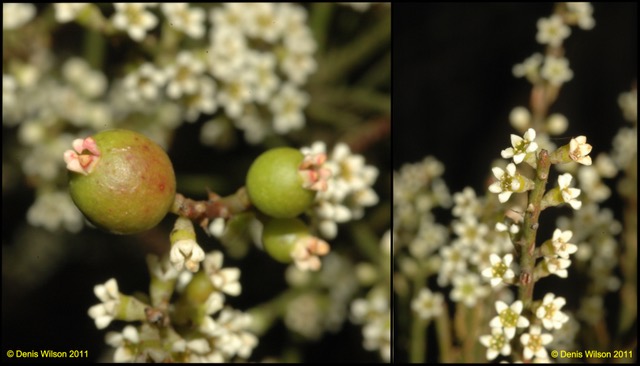
5. Cassytha glabella and C. pubescens (Devil’s twine, CASSYTHACEAE)
Parasitic plants can be generalists, parasitising multiple hosts, sometimes even multiple species, at the one time. Cassytha species are hemiparasitic vines. Soon after the seed of a Cassytha plant germinates, its shoot (which initially contains chlorophyll) swings around in the air until it touches another plant. Then haustoria form, locking into the host plant, and once the Cassytha can obtain sap from the host, the part of the plant that is rooted in the ground dies off and the plant becomes a holoparasite2 . There are two species of Cassytha found in Hawkesbury Sandstone vegetation, the hairy and warty C. pubescens, and C. glabella which has much thinner stems.
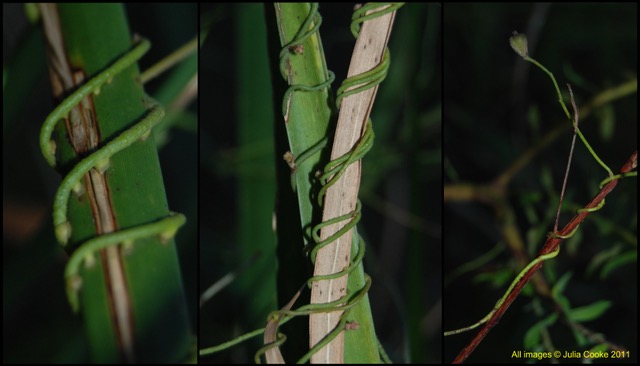
6. Leptomeria acida (Acid drops, native current, SANTALACEAE)
Leptomeria acida is yet another member of the Santalaceae family found on Hawkesbury Sandstones, together with Exocarpus cupressiformis and Choretrum condollei. It is a shrub that grows to 2 m high and a root parasite. This species has leaves that are reduced to scales like those of Exocarpus, and its stems are triangular in cross section. Leptomeria acida produces edible fruits that are very acidic and high in vitamin C3.
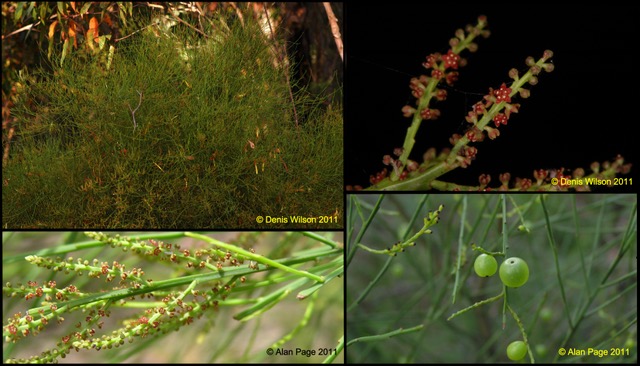
7. Cryptostylis erecta and C. subulata (Slipper orchids, ORCHIDACEAE)
Some plants derive some of their nutrients from mycorrhizal fungi. These are called myco-heterotrophs rather than parasites as the plant provides sugars to the fungi. Many orchids are myco-heterotrophs including Cryptostylis erecta (hooded orchid) and C. subulata (large tongue orchid) that grow in Hawkesbury Sandstone vegetation. For much of the year, these orchids appear as a single leaf growing from the ground. Cryptostylis erecta is easily distinguished by the purple undersurface of the leaf. In spring several flowers are produced on long stems which are pollinated by male wasps which mistake the flowers for female wasps4. This pollination strategy is called sexual deception. The orchids produce dust-like seeds and with almost no reserves stored in the seeds and young orchid plants they are dependent on locating mycorrhizal fungi very soon after germination. In their youngest stages, all orchid plants can be deemed to be parasitic.
There are many other species of orchid that can be found in on Hawkesbury Sandstones, with some pictured below. One example is Dipodium puctatum5. This species, also known as the slender hyacinth orchid, has minimal or no development of green, chlorophyll-rich leaves or stems, and therefore cannot share sugars with fungal partners making it virtually parasitic for its whole existence.
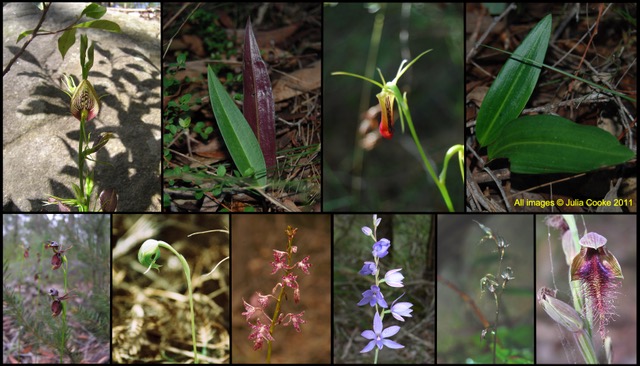
Carnivorous Plants
In contrast to parasitic plants, carnivorous plants acquire some of their nutrients, but not energy, from animals or protozoa rather than from other plants. They don’t acquire sugars from their prey which means they still need to produce chlorophyll for photosynthesis. Nitrogen from amino acids in the insects’ bodies is one of the most important elements acquired by the plants in this way. There are over 600 species of carnivorous plants worldwide.
8. Drosera peltata (Sundew, DROSERACEAE)
You may find Drosera peltata or D. spathulata growing on damp patches of sandy soil. The leaves of Drosera spathulata grow in a rosette. All leaves have reddish glandular hairs each tipped with a drop of clear, sticky liquid that trap small insects. Once captured, the leaves roll up enclosing the insect which is dissolved and digested, providing the plant with nitrogen, an often limited element in the nutrient-poor sandy soil. Drosera peltata has a long, erect stem with stalked crescent-shaped leaves that are also capable of catching animals. Drosera species absorb nutrients through their roots and are capable of photosynthesis, so the insect meals can be considered as supplements. They are very attractive plants, both because of their dainty flowers and glistening, colourful leaves. On some Drosera you may find insects that are not captured by the leaves but are able to walk delicately between the sticky hairs and steal insects caught in the leaves as food. These bugs, called mirid bugs, Setocoris spp., are known kleptoparasites which means parasites by theft.
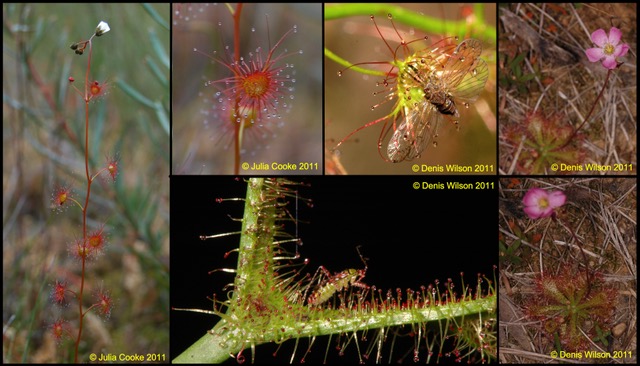
9. Utricularia species (LENTIBULARIACEAE)
By rivers, small tributaries or other wet areas, you might be lucky enough to find Utricularia plants. These may look delicate, but are still carnivorous plants using different mechanisms from Drosera and Stylidium to capture food. Utricularia species have modified leaves forming small bladders and grow in the water, low on the stem. The bladders suck in small amounts of water together with their prey organisms. When the captured organisms are digested, the traps reset. There are several species of Ultricularia that occur in Hawkesbury Sandstone vegetation including U. biloba, U. dichotoma, U. gibba, U. laterifolia, U. uliginosa and U. uniflora.
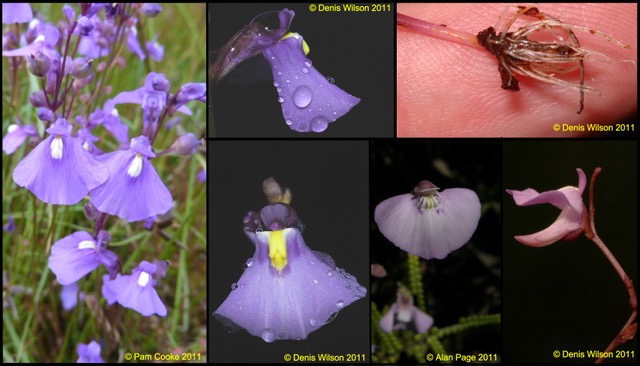
10. Stylidium productum (STYLIDIACEAE)
Stylidium productum is a perennial herb that can be found year-round. There are over 140 Stylidium species, most are Australian, and they are commonly called trigger plants. Stylidium species have glandular trichomes on the flowers and scape which may catch and digest small insects6 although they are better known for their triggered pollination mechanism than for their carnivory.
Stylidium flowers have a very unusual mechanism for pollination. Two anthers and the style are fused together on an elastic stalk which is normally bent back behind the flower. When the centre of the flower is touched, usually by an insect, a trigger releases the style and anthers which fly forward, showering the pollinator with pollen or collecting pollen from a previously pollen-showered insect. Kinetic energy is necessary for the rapid firing of the flower column. Potassium ions pumped into specialised cells generate hydrostatic pressure through osmosis, and therefore potential energy that can be released when the trigger is activated. The speed of the hammer is achieved by the opening of ion channels in the membranes of these specialised cells; they open in an instant, releasing the ions, followed by water and thus the hydrostatic pressure7. The trigger resets itself by moving the ions back into the specialised cells. You can trigger the mechanism by gently inserting a small twig into the middle of the flower.
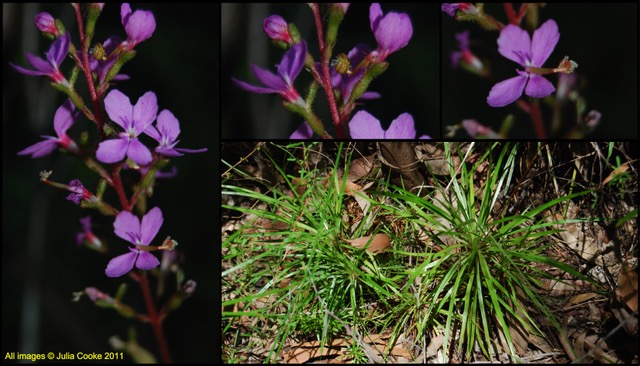
Conclusion
What a range of parasitic and carnivorous plants! Why are there so many? The sandy soils derived from Hawkesbury Sandstone are very low in nutrients and retain minimal moisture. They are particularly low not only in phosphorus but also in nitrogen8,9. Carnivory and parasitism in plants are considered adaptations to low nutrient soils as they provide an alternative method of acquiring nutrients rather than absorbing them through their roots10. This is one explanation as to why there are so many carnivorous and parasitic plant species in this vegetation type. Can you think of any others?
How many species have you spotted?
2-4 species: Good botanical vampire hunter with potential.
5-8 species: You’re a natural botanical vampire hunter.
9+ species: Supreme botanical vampire hunter!
1Downey, P.O. 1998. An inventory of host species for each aerial mistletoe species (Loranthaceae and Viscaceae) in Australia. Cunninghamia, 5(3): 685-720.
2 Hamilton, A.G. 1914. The Flora of the South Coast. Handbook for New South Wales, British Association for the Advancement of Science.
3 Robertson, L. 2003. Field Guide to the Native Plants of Sydney. 3rd Edition. Kangaroo Press, Pymble, NSW.
4 Schiestl, F.P. et al. 2004. Chemical communication in the sexually deceptive orchid genus Cryptostylis. Botanical Journal of the Linnean Society, 144(2):199-205.
5 Bougoure, J.J. and Dearnaley, J., 2005. The fungal endophytes of Dipodium variegatum (Orchidaceae). Australasian Mycologist, 24(1): 15-19.
6 Darnowski, D.W., Carroll, D.M., Płachno, B., Kabanoff, E. and Cinnamon, E., 2006. Evidence of protocarnivory in triggerplants (Stylidium spp.; Stylidiaceae). Plant Biology, pp.805-812.
7 Atwell B.J., Kriedemann P.E., Turnbull C.G.N. (1999). Plants in Action: Adaptation in Nature, Performance in Cultivation. South Yarra [Vic.], Macmillan Education Australia.
8 Beadle, N.C.W. 1962. Soil phosphate and the delimitation on plant communities in eastern Australia II. Ecology, 43(2): 281-288.
9 Hannon, N.J., 1956. The status of nitrogen in the Hawkesbury sandstone soils and their plant communities in the Sydney District: I. The Significance and Level of Nitrogen. Proceedings of the Linnean Society of New South Wales, 81: 119-143.
10 Adamec, L. 1997. Mineral nutrition of carnivorous plants: a review. Botanical Review 63(3): 273-299.
